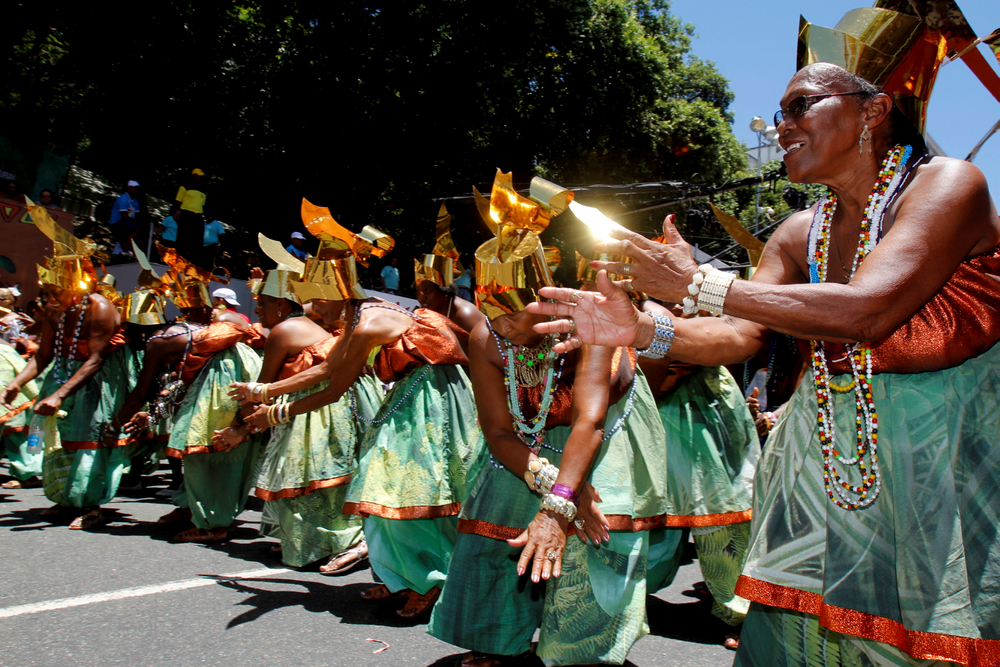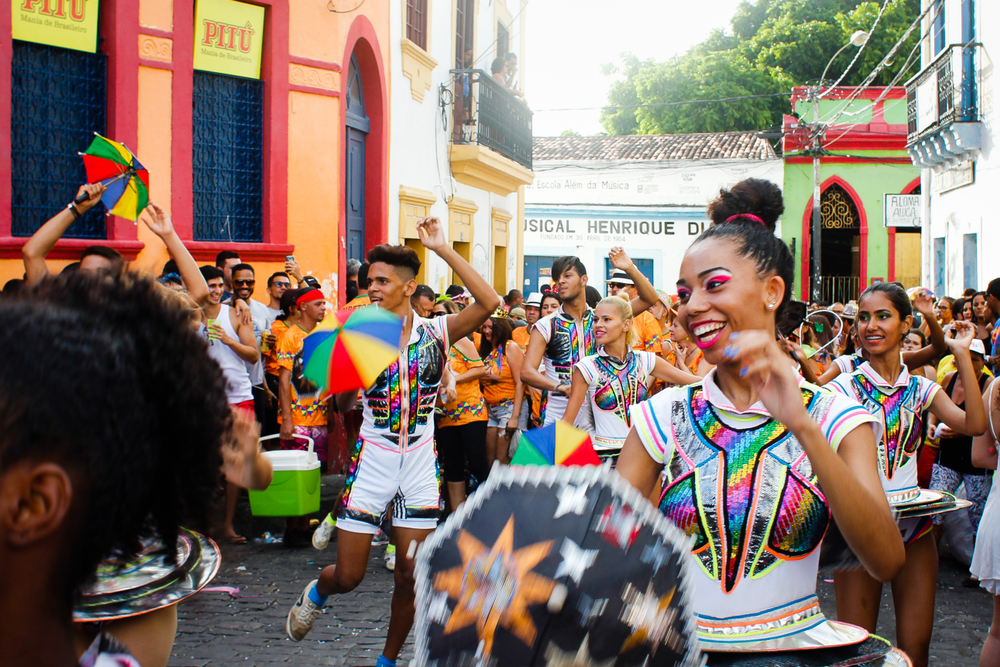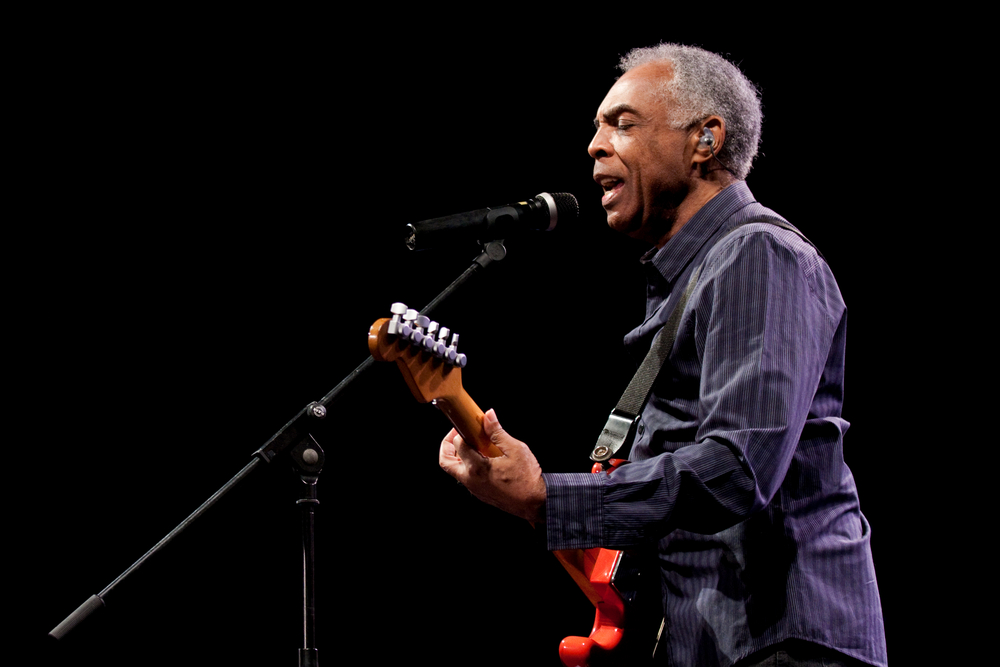The music scene in Brazil is diverse and growing. European, African, and even Amerindian influences are seen today in the country’s music scene. All types of music seem to be growing in popularity here. Outside of the country, the international scene recognizes samba the most.
This type of music has been popularized by the Rio de Janeiro Carnival. Alongside samba, bossa nova has also been growing in popularity outside Brazil. Both vocal and instrumental types of music distinguish themselves into the following genres in the country.
Table of Contents
1. Afoxe

This type of music is a sub-genre of tropicalia. It is dominated by its Candomble religion influence. This African-origin religion is very orientated towards extroverted singing and behavior. If other religions encourage private meditation and practice, Candomble encourages public singing and dancing.
This is why Afoxe music is mainly popular in large festivals across Brazil. It’s seen every year in the Rio de Janeiro Carnival where it attracts hundreds of participants from numerous Candomble communities across the country.
2. Arrocha
Like many Brazilian music genres, Arrocha originates in the Bahia region of the country. This type of music has been popular in the country for at least 5 decades. However, it wasn’t called Arrocha until recently.
Large interest from investors who saw the potential in this music genre saw its name come to light. Artists were primarily known as singers with electronic keyboards and this instrument lives on today in the modern versions of Arrocha. This music is generally influenced by its lyrics with themes of love. Nano do Arrocha is one of the top artists in this music genre emerging over the past few years. The artists had a role in creating a modern Arrocha twist while maintaining its original influences from electronic music.
3. Axe

Axe is a type of Brazilian music with African and Caribbean influences. It is also influenced by local music genres such as reggae and calypso. This type of music is characteristic to soul music fans and it is known for its positive rhythm and lyrics. Part of this music is also influenced by the local Candomble religion. This religion first appeared in the Afro-Brazilian communities of the country in the 19th century. Ivete Sangalo is considered the most successful Axe musician on an international level.
4. Baiao
Baiao is a type of rural music originating in the Amerindian elements of Brazil. Throughout history, it also mixed with African influences to become music of rhythm and joy. This type of music is rather simple through its rural influence but it has a constant rhythm. The rhythm of Baiao is generally in the hands of the artists playing the drums. A small set of drums called ‘zambumba’ are used for this type of music.
5. Batacuda
Batacuda is a type of Brazilian music of African influence. It is music performed in a group. Instruments are often used to perform Batacuda songs. Various drums such as the surdo or repinique drums are used to create an ensemble instrumental.
6. Bossa nova

Bossa nova is a type of samba music characterized by a different rhythm and by plenty of unconventional chords. Some consider it an over-simplification of samba music or initiation to samba music through a simpler rhythm.
This type of music comes from the neighborhoods of Rio de Janeiro. Its etymology can shed new light on what this music represents to the locals. The word ‘bossa’ refers to something made with style or with a natural ability that cannot be learned. Classical guitars and drums are characteristic of this type of music.
7. Brazilian hip hop

Brazilian hip hop has emerged from the Afro-Brazilian groups of Teixeira in the Paraiba region of the country. Many believe hip hop here emerged sooner than the hip hop of North America. Groups in the Teixeira region have been known for their very specific poetic lyrics which had to be recited in a clear rhythm and with coherence. Early Brazilian hip hop singers were called repentistas.
Later on, the country’s hip hop scene settled in Rio de Janeiro and Sao Paolo. This type of music also made its international debut with Brazilian hip hop artists performing at concerts around the world.
8. Brazilian jazz

Brazilian jazz is a type of music with local and international influences. Bossa nova and samba artists have traveled abroad initially where they encountered jazz. The first Brazilian jazz artists were largely localizing jazz to the culture of Brazil.
Today, Brazilian jazz exists both in Brazil and abroad, as a music genre itself. Those who want to start listening to this music genre can look at artists such as Flora Purim, one of the first true Latin jazz artists. The music genre is very popular with street celebrations and at private events.
9. Brazilian rock

Brazilian rock entered the country in the early 1950s. This was a time of experimentation as the rock lifestyle was proposing different dogmas to what Brazilians were used to. However, the electronic guitar was already used in the country for a few years and rock soon caught on.
Over the next decades, the local rock scene flourished. Many great singers and bands came from here. Among them, Sepultura marked the 80s and the early 90s of the local and international thrash metal and groove metal scene. The band, like many others from Brazil, went into a decline with a rock in general over the past few years.
10. Brega

Brega music is a bit more difficult to define. It refers to popular music, typically involving lyrics of love, but to an exaggerated extent. The dramatic interpretation of this music doesn’t have a particular rhythm such as samba or Brazilian hip hop. It has varying rhythms.
The main themes of Brega revolve alongside feelings of love. Characteristic to Latin America, these lyrics are about seeking love or losing love. Brega also features plenty of songs and artists singing about betrayal, typically in love.
11. Carnival

Carnival is a type of musical melting pot in Brazil. Best exemplified by Rio de Janeiro’s Carnival, it encompasses multiple music genres, but specifically samba and frevo. These two music genres are mostly suitable for carnival events and Brazilians have adapted them for carnival-specific dancing as well.
Carnival music tends to encompass all genres sung in Brazil. Since the largest carnivals have a jury, this carnival music tends to be summarized or presented in a short version when the carnival goes past the jury. This is why carnival music is easy to learn and to get into as it tends to have a repetitive nature. Carnival music is also the main theme for many music and dance schools around Brazil. They are mostly found in Rio de Janeiro and Sao Paolo.
Carnival music is also popular at events such as weddings and birthday party celebrations. It’s not typical for this music to be played in a small event due to its effervescent nature.
12. Choro
Choro is a type of instrumental Brazilian music. It has emerged in the late 19th century and it is played with instruments such as guitars and flutes. Choro is a joyful type of music and many believe it encompasses the joyful nature of Brazilians the best.
A fast rhythm and plenty of improvisation characterize choro further. This type of urban music only started to become popular as more radios were available throughout the country. Starting with the 1950s, this music genre started to make its way into the mainstream stations. This type of music was then revitalized in the ‘70s and it still lives today even outside of the country.
13. Coco
Coco is a type of music of African influence mainly found in the Northeastern region of Brazil. It even has its dance with dancers wearing wooden clogs. This genre relies on simple musical instruments such as triangles, surdos, ganzas, and pandiros.
It’s not clear who brought this music genres to Brazil. Conflicting theories tell a story about the music coming from Africa. A large majority of singers of Coco believe this music comes from Angola.
14. Forro

Forro is a type of music specific to the Northeast region of Brazil. It is the most popular type of music in this type of country differentiating itself from the music of the South. It is believed this music genre originated on local farms where farmers used to sing while doing their chores such as feeding cattle or gathering coffee.
Forro also has a dance style attached to its name. If the Forro music is very specific for the Northeast region, Forro dancing combines dancing influences of North and Southern Brazil. Forro is also highly established as a music genre abroad, specifically in Europe.
15. Frevo

Frevo is a type of instrumental music interpreted with trumpets, trombones, and brass instruments. It is believed to be over 100 years old and it is widespread across Brazil, specifically in football stadiums and carnivals.
It is believed this music got its name from the ‘fever’ or ‘boiling’ nature that makes listeners dance for a long time when they hear it. Instruments such as saxophones are used to make this type of music even more popular as it starts to be heard around the world at many outdoor festivals.
Dancing to Frevo is also possible. Given its effervescence, Frevo is often associated with arrhythmic dancing and it can be one of the simplest Brazilian dances to get into while listening to Frevo music.
16. Funk carioca
Funk carioca is a type of Brazilian hip hop. It takes its inspiration from international hip hop music, particularly Miami bass. Gangsta rap music is also an influence of funk carioca.
Funk carioca is characterized by electro rhythms to which artists rap. A romantic or photorealistic lyrical tune is also characteristic of this type of music. Originating from the favelas subcultures, it comes with all of the attributes of life in these violent neighborhoods. This type of music has been characterized by its violent lyrics as well as explicit sex references. While it used to be a music genre only known to Brazilians, it has been popularized in Europe after the year 2000 through dedicated radio shows and concerts.
17. Funk ostentacao
This music genre was only created in 2008 and it quickly became popular with the youth. It’s normally associated with the country’s new middle class. This class of young professionals or young people, in general, are determined to reach major life goals, and this can be heard in the lyrics of the songs.
Created in Sao Paolo, the music genre typically impresses with its overall versatility to the everyday lifestyle of those in the favelas. People dream of better lives and they put this into lyrics. Funk artists in Brazil are also crossing over to themes of rap such as cars, women, and wealth. Television publicity for this type of music is considered extensive.
18. Gospel

Gospel is a type of religious singing rooted in the reformed tradition within Protestantism, specifically within Presbyterianism. It has been popularized across North America in the 19th century both in religious services and for its aesthetic pleasure. Black communities within North America were among the first to popularize a version of the gospel where a lead singer was followed by a choir in sinning.
In Brazil, this type of music has been made popular through reformed tradition Protestantism. It has been adapted to the local culture from traditional gospel, urban gospel, and Southern gospel.
19. Jongo

Jongo is one of the few music genres originating from Southeastern Brazil. This type of music was initially found in the black slave communities working on local coffee farms. To makes their evenings a bit more pleasurable, slaves used to gather around sing, and dance jongo.
This music genre involves a vocalist singing short lyric songs followed by an answer from another vocalist or a crowd. Traditionally, jongo would take place in black groups where the vocalist would sing together with the group. A single person or a couple would also dance jongo in the middle of the group during the singing.
20. Lambada

Lambada is one of the most popular types of music and dance from Brazil. Lambada dancing is now popular across the world its lambada music rhythms are attributed to the Brazilian musician Pinduca.
Lambada is a quintessential Latin dance in partners. A man and a woman dance together with swaying movements. This dance has a romantic side taking influences from forro, salsa, and other dancing genres.
The music genre of lambada is very specific to this dance. This type of dance is known for its partners dancing very close together and as a result, it needs to represent this closeness. Lambada has further developed into multiple sub-genres, specifically by local influence around South America.
As far as international success goes, lambada is one of the most popular types of music to come from Brazil. It gained maximum popularity in the ‘90s when Brazilian lambada music was popular across Europe and North America. Even today, there are dance schools around the world only focusing on lambada dancing using lambada music.
21. Latin jazz

Latin jazz is found with its two main influences in Brazil. Both Afro-Cuban and Afro-Brazilian jazz is played in Brazil. Influences of Afro-Brazilian jazz are traced back to the early days of Bossa nova in the 1950s. As expected, the Latin rhythm of this type of music is highly present in the Brazilian type of jazz.
Among the first artists of the genre, Airto Moreira impressed the local music scene the most. The introduction of multiple percussion instruments led to the creation of a new type of Latin American jazz. Shakers and bells were introduced in this type of music by the artist together with other unlikely instruments specific to carnivals such as whistles.
22. Mangue bit
Mangue bit is a type of music originating in the city of Recife in Northeastern Brazil. It was first heard in the ‘90s when it was introduced as a way to culturally recharge a drifting city also seeing plenty of financial problems.
The movement that started was called Mangue bit and it was characterized by a new wave of cultural influences with electronic music being one of its most important aspects. It’s most resembles an alternative rock, maracatu, and frevo music.
23. Maracatu

Maracatu is a type of music popular in the Brazilian cities of Pernambuco region. This music genre is specific to carnivals and people in Brazil generally associate it with dancing. Choir singing and instruments are specific elements of this type of music which is further specialized into Maracatu rural and Maracatu national.
This type of music is generally sung during carnivals in parts of Brazil. It also comes with attached dance culture. All the participants of the carnival are gathered around a designated carnival king and queen.
It’s not unusual to see Maracatu singers dress in traditional costumes during carnivals. Both maracatu singers and dancers are attracted to vivid color costumes that associate well with the vivacious maracatu music.
24. Marchinha
Marchinha is a march-style dance from Brazil. It has been specifically made for the Carnival of Rio and it represents a type of music that also features specific dancing. It is a comical type of music and dance used as a satire. Both musicians and dancers march similarly to army troops while singing.
This style of music has been popularized around the world through the Rio de Janeiro Carnival. Music fans can also learn to play it with instruments such as tubas and horns. These instruments are also specific to army orchestras.
25. Maxixe
Maxixe is one of the oldest music genres in Brazil. It has been dated to 1868 in the African communities of the country. It’s believed it has grown from the same period tango was developed in neighboring Argentina.
Maxixe is a type of music heard with the Maxixe dance. This dance has mixed samba and lambada elements, also of African origin with a local Brazilian influence. Today, Maxixe is seen as a type of choro music and it is still popular among the country’s thousands of dance schools.
26. Merengue music

Merengue is a popular type of music in Brazil. It originates in Trinidad Tobago but it’s found all across Latin America, including Brazil. Played with drums and in different rhythms and styles, merengue is typically the Latin American dance singing for couples. It’s popular in male-female dances and it uses only a few instruments such as specialized drums and accordions.
27. Modinha
Modinha is a type of pop music found both in Brazil and other Portuguese-speaking countries. Its origins are a bit uncertain. Some claim it originates in Portugal while Brazilians said the music comes from their country.
Whichever its origins are, this type of music roughly translated as ‘fashion music’ is dominated by themes of love. Generally happy and uplifting, it’s a type of music that is easy to memorize and easy to market on radios and the TV. Harmonic instruments are often used to create modinha and this type of music is expected to further divide into multiple sub-genres shortly.
28. Musica popular brasileira
Musica popular Brasileira is a modern type of Brazilian music. It has a few known genres and a few distinct sub-genres within its category. Artists such as Jorge Ben Jor have been known to carve their path within music popular Brasileira with a distinct music style.
It is believed this modern urban music style was first heard in the post bossa nova music era in Brazil. It is a combination of traditional types of music such as samba and samba-cancao. Stylistic influences in musica popular Brasileira can also include jazz of foreign influence, a rock of foreign influence, and other local types of Brazilian music.
29. Musica sertaneja
Musica sertaneja used to be the most popular type of music in certain regions of Brazil from 2000 to 2010. This type of music also has long historic roots. It is believed it comes from rural areas but it has been revitalized by university students who introduced new instruments to it such as guitars and violas.
The wide appeal with the youth as well as the somewhat simple rhythm and lyrics that are easy to memorize made this music style so popular. Today, this music genre is popular through various artists who make their impact on it with an instrument such as electric guitars and accordions.
30. Pagode

Pagode originated in Rio de Janeiro. It is considered a genre of samba music. But critics say this type of music is more in tune with true samba by exaggerating all of its clichés. As a result, pagoda made its way into the popular mainstream media and it’s characteristic of Brazilian culture as much or more than samba. Its lyrics are dominated by slang and Brazilian local terms. Underground words from Rio de Janeiro’s favelas are also intensely used in this music.
Pagode is also one of the most hated or unappreciated genres in Brazil. The often exaggerated stylistic of this music prevents it from being easy to consume for certain categories of people. Still, it has its place in parties and carnivals like most other music genres.
31. Rap

Rapping is a popular music genre in Brazil. Widely influenced by the successful rappers in North American, Brazilian rap includes themes of local interest. Many Brazilian rappers criticize public policies and this tends to attract new crowds through political views.
Rap music in general is characterized by lyrics of spoken or sang words to a beat or rhythm. There’s plenty of local influence on rhythm in Brazilian rap. Furthermore, the culture surrounding rap music in Brazil has been capture on the big screen with movies such as Favela Rising.
Brazilian rap is often subject to the same obstacles the genre has in Northern America. Often associated with gang violence and short-lived bands and artists, it can fail to remain relevant in the long term.
But for most Brazilian youth, their country’s rap scene is a way out of the favelas as seen in these movies exemplifying life in the outskirts of the large cities. In some cases, Brazilian rap has often tied communities together, but not to the same extent as samba has with its hundreds of thousands of schools around the country.
32. Rasteirinha
Rasteirinha music is a type of Brazilian electronic music. It has recognizable roots in reggaeton. But it also has influences from other popular genres such as funk carioca. One of the most intriguing influences in this type of music is samba and axe. To an extent, this is what differentiates rasteirinha from general reggaeton music.
33. Samba

Samba is one of the most popular types of music in Brazil. It has exploded in popularity after 1920 and it comes from the outskirts of Rio de Janeiro. Samba is considered a Brazilian national symbol as many people associate it with their national identity.
This type of music is believed to have emerged from rural cultures of West Africa and Brazilian folk music. The combination of these genres was at the roots of this popular type of music. You can find all types of musical instruments in samba. They include pandeiro, surdo, cuica, and ganza instruments.
34. Samba-cancao
Samba-cancao (ie. canção) is a type of slow-paced samba music. It was first described under this name after World War II when it entered the public scene. Many artists don’t describe themselves as samba-cancao singers as this music genre name was given by the media.
Slower by pace, it is generally touched by lyrics of love and love life. Samba cancao is a popular alternative to jazz music in restaurants, concert halls, or other private events. It is also a popular genre among talented Brazilian vocalists.
Good vocalists have never been hard to find in Brazil. Some of the best vocalists of the country are singing cancao songs with a samba influence. These vocalists are rarely trained as most come from rural or urban areas where music is a way of life.
35. Samba de breque
Samba de breque is one of the funny music genres that emerged in Brazil. It represents one of the most popular genres for those who like experimental music. Breque stands for ‘brake’ which represents
36. Samba reggae

Samba reggae is a type of Brazilian reggae that is influenced by the traditional forms of music. Largely based on Bob Marley’s interpretation of reggae, its Brazilian version is also slow-paced. It’s believed it should only be sung in the parameters of up to 120 beats per minute.
Surdo, a type of drum, is used to create these beats. This small drum is typically found in 3 sizes around Brazil and it creates the rhythm of the music. This genre has been influenced by the African communities around the country the most. These communities gave it another spin, which includes samba dancing.
Typically at a slower pace than samba dancing, samba reggae dancing is usually seen in groups and rarely in couples. A group leader sets the tone of the dance rhythm and the rest of the group follows. This type of dance can be seen all over the beaches of Brazil during the evening. Bars, restaurants, and other places that might have more people interested in dancing are the perfect setting for samba reggae dancing.
37. Samba rock

Samba rock has its roots in the favelas of Rio de Janeiro. This type of music is also influenced by the lower class African-origin communities at the roots of samba. But the introduction of rock and roll to the country from North America created a new samba culture with electric guitars and musical styles that eventually went on to become samba rock. Dancers are involved in this style of rock, true to its samba origin.
Samba rock is also popular across Latin America and Portuguese-speaking countries. This type of rock has never been truly popular outside the country and, likely, it never will become popular in North America outside Latino communities given its cultural influences.
38. Samba-choro

Samba choro is a type of instrumental music inspired by samba and Brazilian choro with a slower tempo. The presence of lyrics is important as well. This medium-paced samba has emerged in the 1930’s Brazil. Since then, it has become an independent music genre with various musical instruments. Among them, the flute and the trumpet tend to be the most popular.
39. Samba-enredo
Samba-enredo is a type of music characterized by summarization of lyrics and rhythms, mainly to highlight the chorus. This music has been specifically made for the Rio de Janeiro Carnival as bands pass its streets singing and dancing to a specific theme.
Made for shows, this type of music is characterized by a different theme with each song or collection of songs. Each year, dancing groups make their way to the Rio de Janeiro Festival with a new tune and a new samba-enredo theme.
Samba-enredo is rarely heard outside Brazil. It would be very difficult to implement outside Brazilian communities as the music genre summarizes all other major musical styles and popular songs of the country. This is why it can take years to master Samba-enredo, a summarization type of music that stretches across multiple musical styles.
40. Samba-jazz

Samba-jazz has its roots in the 1950’s Brazil. It interprets part of samba with American jazz to create a new music genre. Bepop is the major jazz influence on Samba-jazz in Brazil. Initially, this style of music was a bit difficult to implement with new artists on the local level. This is why the first samba-jazz Brazilian artist was particularly experimented with and already enjoying popularity on the local music scene.
The influences of Brazilian jazz also juxtapose jazz in general. This is why today there are artists in North America and Europe performing jazz with Brazilian influences. In some cases, this type of jazz is particularly popular. Beach events and beach parties are typically among the first to take on a more Latin American jazz style which is often the best place for outdoor dancing as well.
41. Sambass
Sambass is the localized version of drum and bass in Brazil. The music genre has gained traction over the past few years with artists such as Dj Patife and it represents a recognizable type of drum and bass on an international level. However, it maintains a Latin influence from samba music.
42. Sertanejo universitario
Brega, arrocha, and forro are among the biggest infleunces on sertanejo unversitario. As its name suggest, this type of music started among the youth, often university-goers. These youth updated classic pop Brazilian music to a modern version of music to their liking. They replaced instruments such as accordions with electronic guitars and even developed a dance style to go with the new upcoming music genre.
43. Stronda
Stronda is one of the many urban music genres in the country. It can be seen as a combination of hip hop, rap, funk, pop, and even surf music. Taking its major influence from hip hop, it’s the type of music where rapping is important. Lyrics are often censored when aired on TV or the radio as this music comes straight from the favelas.
Seen as the local alternative to American Hip Hop, Stronda is the type of music that has influences in instrumental music as well. Some of the favorite instruments in this genre include drums, bass, and electronic guitars. But a voice, particularly rapping, is the main attribute of stronda music.
Officially, stronda is quite new to the Brazilian music scene. It has only been defined back in 2004 but bands singing a similar time of music with rap influence have been seen around Rio de Janeiro for at least a decade before.
44. Techno brega
Techno brega is a type of Brazilian music remastering popular music from the ‘80s. These music mixes are often sold on the street as played as party music. Techno brega never made it to the big music studios.
It represents a genre that is made by the people for the people. Most types of techno brega aren’t even produced in professional music studios. People record this genre at home and later sell them on CDs or other types of the medium on the streets.
45. Thrash metal

Sepultura, Dorsal, and even Executer are some of the most popular Brazilian thrash metal bands. This type of music came into the country through international medium and it quickly rose to popularity in the ’80s.
The fast-paced singing of trash metal soon caught on in Brazil. Singing against the establishment and often referring to violent lyrics characterizes this genre even if themes of love aren’t unheard of either. The often uncensored lyrics and constant criticism this music brings to social dogmas put this type of music in opposition to Christianity where it gets most of its criticism from.
46. Tropicalia

Tropicalia is an atypical type of Brazilian music seen in the ‘60s. It has been characterized by a music genre with influences from other fields such as theatre and poetry. This is what initially made it hard to market and why so many tropicalia artists conflicted with the media.
Tropicalia singers were also known for their political activism in times of Brazilian military rule. Today, tropicalia mostly exists in the Bahia region, and singers describe themselves as post-tropicalia artists. Since many singers were also active, they had to flee the country for safety. The story of this music genre can be seen in the 2012 Tropicalia movie.
47. Vanguarda Paulista
Vanguarda Paulist is one of the general music styles in Brazil influenced by the quest for freedom. It emerged as a cultural and political movement in the final period of the Brazilian dictatorship. This movement even had its performance hall where artists from all types of music genres used to perfume.
In general, Vanguarda Paulista can be closer to rap music than to any other type of music. Spoken word artists had the easiest task to put their political views into their songs. Often satirical, Vanguarda songs used to bring people together under one common goal. This type of music and its political views survives through various artists to this day.
















